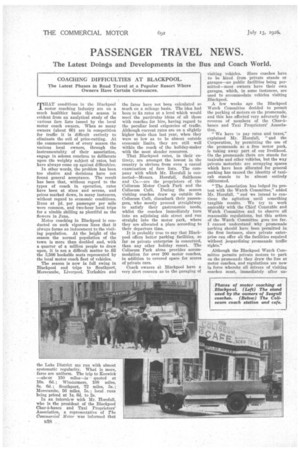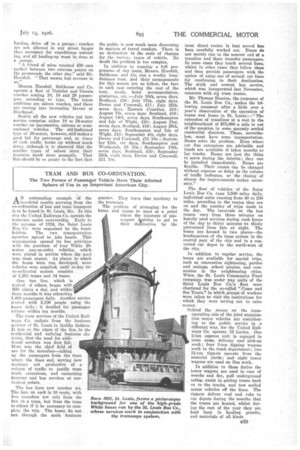• PASSENGER TRAVEL NEWS.
Page 22

Page 23

If you've noticed an error in this article please click here to report it so we can fix it.
The Latest Doings and Developments in the Bus and Coach World.
COACHING DIFFICULTIES AT BLACKPOOL.
The Latest Phases in Road Travel at a Popular Resort Where Owners Have Certain Grievances.
THAT conditions in • the Blackpool motor coaching industry are an a much healthier basis this season is evident from an analytical study of the various fare lists issued by the local motor coach owners, When so many owners (about 60) are in competition for traffic it is difficult entirely to eliminate the evil of price-cutting. At the commencement of every season the various local owners, through the instrumentality of their association, engage in solemn conclave to deliberate upon the weighty subject of rates, but have always come up against difficulties.
In other words, the problem has been too elusive and decisions have not found general acceptance. The result has been that, without regard to the types of coach in operation, rates have been at sixes and sevens, and prices marked down, in many instances, -without regard to economic conditions. Buns at id. per passenger per mile were common, and two-hour local trips for a nimble shilling as plentiful as the flowers in June.
Motor coaching in Blackpool is conducted on such vigorous lines that it always forms an inducement to the visiting population. At the height of the season the normal population of the town is more than doubled and, with a quarter of a million people to draw, upon, it is not a difficult matter to fill the 2,500 hookable seats represented by the local motor coach fleet of vehicles.
The season is now in full swing in Blackpool and trips to Southport, Morecambe, Liverpool, Yorkshire and the fares have not been calculated so much on a mileage basis. The idea had been to fix rates at a level which would meet the particular ideas of all those with coaches for hire, having regard to the peculiar local exigencies of traffic. Although current rates are on a slightly higher basis than last year, when they were so low as to be almost outside economic limits, they are still well within the reach of the holiday-maker with the most slender resources.
That Blackpool rates, in their entirety, are amongst the lowest in the country is obvious from even a casual examination of fare lists. The company with which Mr. Horsf all is connected—Messrs. Iforsfall, Salthouse and Co.—are the proprietors of the Coliseum Motor Coach Park and the Coliseum Cafe. During the season visiting coaches draw up outside the Coliseum Café, disembark their passengers, who mostly proceed straightway to satisfy their gastronomic needs, whilst the coaches immediately turn into an adjoining side street and run straight into the motor park, where they are allocated a place according to their departure time.
It is probably true to say that Blackpool offers better parking facilities, so far as private enterprise is concerned, than any other holiday resort. The Coliseum Park alone provides accommodation for over 200 motor coaches, in addition to covered space for scores of private cars.
Coach owners at Blackpool have a very alert concern as to the garaging of visiting vehicles. Since coaches have to be hired from private stands or garages—no public facilities being permitted—most owners have their own garages, which, in some instances, are used to accommodate vehicles visiting Blackpool.
A few weeks ago the Blackpool Watch Committee decided to permit the parking of motors on the promenade, and this has affected very adversely the revenue of members of the Char-Abanes and Taxi Proprietors' Association.
We have to pay rates and taxes," explained Mr. Horsfall, "and the Corporation, by permitting the use of the promenade as a free motor park, is taking away part of our livelihood. On the promenade there are stands for taxicabs and other vehicles, but the way private motorist; are occupying spaces which have been allocated for general parking has caused the identity of taxicab stands to be almost entirely obliterated.
" The Association has lodged its protest with the Watch Committee," added Mr. Horsfall and we intend to continue the agitation until something tangible results. We try to work amicably with the Chief Constable and Watch Committee and to observe all reasonable regulations, but this action of the Watch' Committee goes too far. I cannot understand why promenade parking should have been permitted in the first instance, since private enterprise can offer all the facilities required without jeopardizing promenade traffic rights."
Although the Blackpool Watch Committee permits private motors to park on the promenade they draw the line at motor coaches, and regulations are now in force -whereby all drivers of visiting coaches must, immediately after un
loading, drive off to a garage ; coaches are not allowed in any street longer than necessary for expeditious unloading, and all loading-up must be done at a garage.
A friend of mine counted 430 cars parked between two extreme points on the promenade the other day," said Mr. Horsfall. "That means lost revenue to us."
Messrs. Horsfall, Salthouse and Co. operate a fleet of Daimler and Dennis coaches seating 10, 18 and 28 passengers, according to type. The latest additions are saloon coaches, and these are coming into increasing favour at 131aekpool.
Nearly all the new vehicles put into service comprise either 18 or 24-seater coaches on pneumatim saloons or semienclosed vehicles. The old-fashioned type of 28-seater, however, still makes a good bid for patronage and, at times of rush traffic, books up without much delay, although it is observed that the smaller types of saloon start their Journeys much more promptly. That this should be so points to the fact that the public is now much more discerning in matters of travel comfort. There is no distinction in the scale of charges for the variou., types of vehicle. No doubt the problem is too complex.
In addition to running a full programme of day tours, Messrs. Horsfadl, Salthouse and Co. run a weekly longdistance tour, and their arrangements for this season are as follow, the fare in each case covering the cost of the tour, meals, hotel accommodation, gratuities, etc. :—July 10th, seven days, Scotland, £10; Joly 17th, eight days, Devon and Cornwall, £11; July 25th, seven days, Eastern Counties, £10; August 7th, seven days Scotland, £10; August 14th, seven days, Southampton and Isle of Wight, £10; August 21st, seven days, Scotland, £10; August 28th, seven days, Southampton and Isle of Wight, £10; September 4th, eight days,
• Devon and Cornwall, £11 10s. ; September 12th, six days, Southampton and Weyinouth, £8 10s.; September 18th, seven days, Scotland, £10; September 25th, eight days, Devon and Cornwall, ill 108.
TRAM AND BUS CO-ORDINATION.
The Two Forms of Passenger Vehicle Have Their Allotted Sphere of Use in an Important American City.
AN outstanding example of the „beneficial results accruing from the co-ordination of bus and trim transport is to be found in St. Louis, Mo. In this city the United Railways Co. operate the tratnears under receivership. Early in the autumn of 1924, the Saint Louis Bus Cc. were organized by the bondholders. The two transportation agencies agreed to join hands. This organization opened its bus activities with the purchase of four White 29seater pay-on-entry vehicles, which were placed in service where the need was most urgent. As places to which the buses were run developed, more vehicles were acquired, until to-day the co-ordinated system consists of 1,263 trams and 34 buses.
One bus line, which is typical of others, began with 900 riders a day, and within three months it was attracting 1,400 passengers daily. Another service started with 2,100 people using the buses daily ; it doubled its passenger vo4ume within ten months.
The tram services of the United Railways Co. radiate from the business quarter of St. Louis in fanlike fashion. It was on the edges of the fan, in the residential and outlying business districts, that the need for additional services was first felt. Here was the chief field of use for the motorbus—taking up the passengers from the tram where the lines end, serving new territory not productive of a volume of traffic to justify tram track extensions, and connecting tramcar and bus services at con venient points. • The bus lines now number six. The fare on each is 10 cents, with free transfers not only from the bus to a tram, but from the train to others if it be necessary to complete the trip. The buses do not run through the main business quarter. They leave that territory to the tramcars.
The problem of arranging for the buses and trams to meet at a point where the interests of passengers otesiring to get to their destination by the
most direct routes is best served has been carefully worked out. Buses do not merely run to the nearest end of a tramline and there transfer passengers. In some cases they touch several lines, whilst in other cases they follow them and thus provide passengers with the option of using one of several car lines for continuing to their destination. The sixth and newest bus service, which was inaugurated last November, connects with six tram routes.
Mr. Thomas etanion, the treasurer of the St. Louis Bus Co., makes the following comment after a little over a year's observation of the operation of trams and buses in St. Louis:—" The extension of tramlines at a cost in the heighbourhood of $75,000 a mile is out of the question in some sparsely settled residential districts. These, nevertheless, must have some transportation. Buses solve the problem. Even where car line extensions are advisable and funds are available it takes months to lay tracks. Buses are just the thing to serve during the interim ; they can be installed immediately. Buses are flexible. Their routes can be changed without expense or delay as the volume of traffic indicates, or the closing of streets for improvements makes necessary."
The fleet of vehicles of the Saint Louis Bus Co. runs 3,500 miles daily, individual units running from 40 to 250 miles, according to the routes they are on and the number of trips made in the day. The intervals on the bus routes vary from three minutes on heavily used services during rush hours of the day to thirty minutes on thinly patronized 'lines late at night. The buses are housed in two places—the headquarters of the tram system in the central part of the city and in a converted car depot in the north-west of the city.
In addition to regular service, the buses are available for special trips, such as convention sightseeing, parties and outings, school picnics, and ceremonies in the neighbouring cities. When the St. Louis Community Fund campaign was under way units of the Saint Louis Bus Co.'s fleet were chartered for the so-called "Come and See Tours," in which groups of workers were taken to visit the institutions for which they were setting out to raise money.
Behind the scenes on the tramoperating side of the joint organization motor vehicles are contributing to the public service in a different way, for the United Railways Co. operate 15 lorries. One 2-ton express unit is engaged in store room, delivery and pick-up work ; four 2-ton tipping wagons work in the track department ; two 3i-ton tippers operate from the material yards ; and eight tower wagons are used on line work.
In addition to these duties the tower wagons are used in case of wrecks and fire, pull underground cable's, assist in getting trams back on to the tracks, and tow stalled motor vehicles off the lines. The tippers deliver coal and coke to car depots during the months that the trams are heated, whilst during the rest of the year they are kept busy in hauling granite, and materials of all kinds.






























